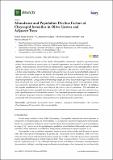Por favor, use este identificador para citar o enlazar a este item:
http://hdl.handle.net/10261/182944COMPARTIR / EXPORTAR:
 SHARE SHARE
 CORE
BASE CORE
BASE
|
|
| Visualizar otros formatos: MARC | Dublin Core | RDF | ORE | MODS | METS | DIDL | DATACITE | |

| Título: | Abundance and population decline factors of chrysopid juveniles in olive groves and adjacent trees |
Autor: | Alcalá Herrera, Rafael CSIC ORCID; Campos, Mercedes CSIC ORCID; González-Salvadó, Marina; Ruano Díaz, Francisca CSIC ORCID | Palabras clave: | Parasitoids Chrysoperla carnea complex Ecological infrastructure Olea europaea Pinus halepensis Prunus dulcis Quercus rotundifolia |
Fecha de publicación: | 7-may-2019 | Editor: | Multidisciplinary Digital Publishing Institute | Citación: | Insects 10(5): 134 (2019) | Resumen: | Numerous species of the family Chrysopidae, commonly found in agroecosystems, whose larvae predate on several pests of economic importance, are regarded as biological control agents. Their abundance and diversity are influenced by vegetation cover, although little is known about the effects of semi-natural habitats on their populations. The objective of this study is to gain a better understanding of the relationship between the trees in semi-natural habitats adjacent to olive groves, juvenile stages of the family Chrysopidae and factors influencing their population decline, which is crucial for an effective habitat management program aimed at conserving these important predators. Using cardboard band traps (eight per tree), the juvenile stages were collected from 25 almond, oak, olive and pine trees over a one-year sampling period. The population decline was caused by parasitoids (26.5%), predators (5.1%) and unknown factors (13.2%). In addition, chrysopids established in olive trees showed the lowest rate of parasitism. We identified ten chrysopid species that emerged from the juveniles collected from almond, oak, olive and pine trees, with a predominance of Pseudomallada prasinus. The chrysopid–parasitoid complex was composed of five species; Baryscapus impeditus (Eulophidae), which was the most abundant, was preferentially associated with Chrysopa pallens, Chrysoperla lucasina and Chrysoperla mediterranea. | Descripción: | © The Author(s). | Versión del editor: | https://doi.org/10.3390/insects10050134 | URI: | http://hdl.handle.net/10261/182944 | DOI: | 10.3390/insects10050134 | ISSN: | 2075-4450 | E-ISSN: | 2075-4450 |
| Aparece en las colecciones: | (EEZ) Artículos |
Ficheros en este ítem:
| Fichero | Descripción | Tamaño | Formato | |
|---|---|---|---|---|
| Abundance_Alcala_Art2019.pdf | 904,7 kB | Adobe PDF |  Visualizar/Abrir |
CORE Recommender
PubMed Central
Citations
2
checked on 11-abr-2024
SCOPUSTM
Citations
10
checked on 15-abr-2024
WEB OF SCIENCETM
Citations
6
checked on 26-feb-2024
Page view(s)
225
checked on 17-abr-2024
Download(s)
251
checked on 17-abr-2024

